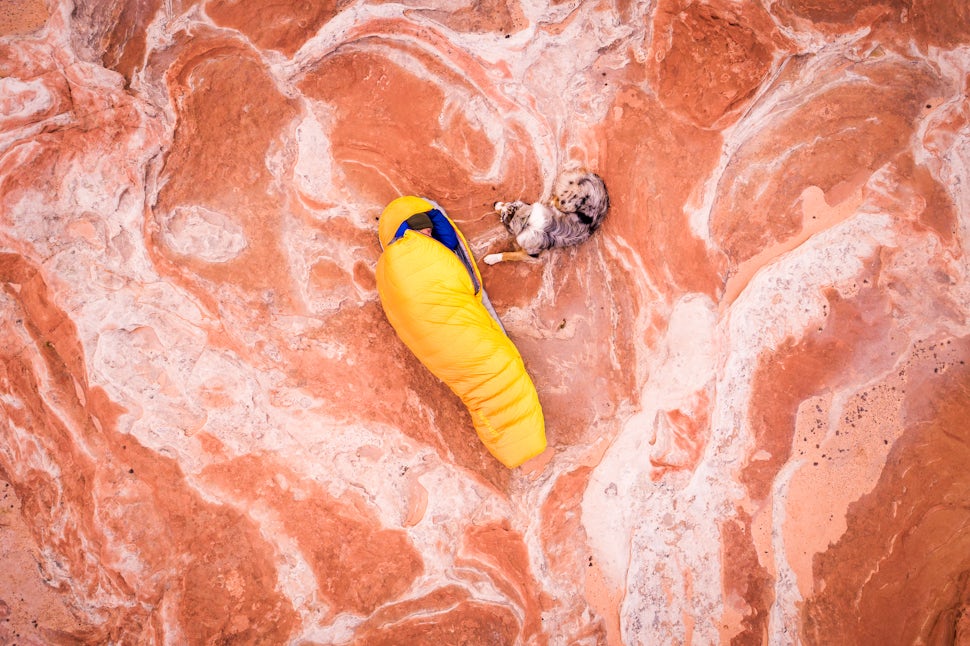Therm-a-Rest Oberon 0˚ Sleeping Bag Review
A stellar sleeping bag for most of your backcountry winter pursuits.

I camp a lot, as in I probably spend at least a third of every year snoozing in a sleeping bag. My current 7-year-old 0˚ bag is at the end of its lifespan; it needs a new zipper, down is coming out regularly, and it's nowhere near as warm and lofty as it used to be. I took great care of it, left it hanging for storage, only washed in a front-loader made with Nikwax Down Wash, it's just seen a ton of use and needs a refurb to be ready for action again (I'm a big fan of repair and reuse!). With an upcoming annual fall trip to the Southwest, a couple weeks of cold desert camping, hiking, and photography, a new bag was sorely needed!
Since I went a month later than normal this year, I was able to test the Therm-a-Rest Oberon™ 0F/-18C Sleeping Bag in nighttime temps ranging from 5˚to 35˚F (⁻15˚to 1.7˚C) in snow, freezing rain, and extreme wind. It's marketed as "crafted for mountaineers, skiers and adventurers that push deep into frigid backcountry winters" and I feel I was able to trial that pretty extensively. I paired it with a Therm-a-Rest NeoAir XTherm (R-Value 5.7) & Z Lite Sol (R-Value 2.2) for the really cold nights and my 25-year-old Therm-a-Rest Classic Standard (R-Value ?) when sleeping in the back of my 4runner.
After using the bag in much more humid conditions than I'm used to in the winter I came away with a lot of love for the 800-fill Nikwax Hydrophobic Down. It never got damp and retained its loft, plus it's Responsible Down Standard Certified and doesn't use any environmentally harmful PFCs. I also really liked the SynergyLink Connectors that kept my sleeping pad in place no matter how much I moved around; it's pretty awesome to wake up in the morning and not find your feet or head on the ground! The straps are also removable if you want to save weight.
My size regular weighs 2 lb. 10.72 oz (1.21 Kg) with straps which is around a pound lighter than my last 0˚ bag. It doesn't feel quite as warm as my old bag used to though. It has an EN Comfort range of 14˚F (-10˚C) and Transition Range of 0˚F (-18˚C). The Transition Range is described as: a "standard man" is “in a situation of fighting against cold (posture is curled up inside the sleeping bag), but in thermal equilibrium” and not shivering. For me that meant I was curled up with the bag at temps around 10˚F or less while wearing light thermals. When I added a fleece blanket or wore my puffy I didn't need to curl up. The large full-length zipper draft tubes are great for sealing the heat, although mine tended to snag in the zipper easily. The shell materials feel thick and durable and withstood the abuse of my 60 lb. Aussie puppy. I've been used to a bag with a little stretch so I'd love to see that incorporated into a future update if possible as I like to sleep in all sorts of weird yoga-esque poses. I'm 5'10" and the regular feels just ever-so-slightly small although it's not tight, the long adds 3 oz but I would probably pick that one if given the choice again.
Therm-a-Rest also added a lot of nice details to the bag. The bottom zipper can be used for venting, there's a zippered pocket for your phone on the outside (although I'd prefer it more accessible on the inside), quilt/blanket loops, and an insulated foot warmer pocket for cold feet. I'm not a fan of the included compression sack as its bulky and cumbersome but most of my time backpacking I won't use a sack at all to save weight. My summer down quilt comes with an amazing ultralight Silnylon Stuff Sack that I wished every brand used!
Overall I'm very happy with the bag and hope to get a ton of use out of it for years to come!
PSA: Help the environment and fight climate change! Consider your requirements before every purchase and only buy what you need. Look at second-hand markets, repair what you have, and spend more if it means you'll be buying a product that lasts longer!
We want to acknowledge and thank the past, present, and future generations of all Native Nations and Indigenous Peoples whose ancestral lands we travel, explore, and play on. Always practice Leave No Trace ethics on your adventures and follow local regulations. Please explore responsibly!
Do you love the outdoors?
Yep, us too. That's why we send you the best local adventures, stories, and expert advice, right to your inbox.














